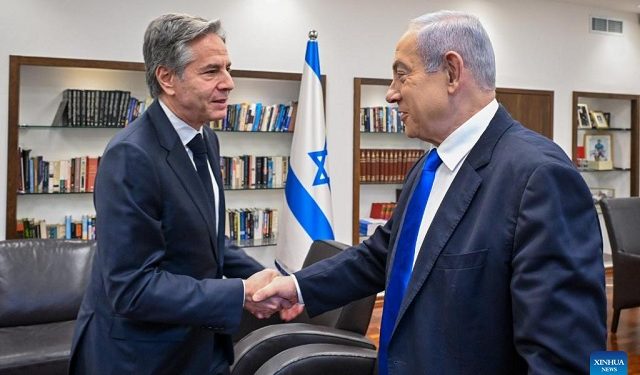By THE INDEPENDENT UG
CAIRO | Xinhua | At the conclusion of U.S. Secretary of State Antony Blinken’s fifth visit to the Middle East since the onset of the ongoing Israel-Palestine conflict, it is evident that the U.S. top diplomat has made little progress in de-escalating tensions in the region.
Similar to his predecessors, Blinken’s latest visit was marked by lofty rhetoric but showed minimal headway in resolving the Gaza crisis.
Blinken engaged in shuttle diplomacy across Saudi Arabia, Egypt, Qatar, Israel, and the West Bank, confronting a complex regional landscape characterized by escalating violence and diplomatic impasses.
As the Gaza conflict enters its fifth month, tensions persist throughout the Middle East. U.S. crackdowns on militias in Syria and Iraq align with a notable increase in airstrikes against Houthi targets in Yemen, raising concerns about further regional instability.
In the initial leg of his visit, Blinken met with Saudi Crown Prince Mohammed bin Salman, aiming to advance talks on Saudi-Israeli normalization. Despite expressing continued interest, Saudi officials reiterated that progress hinges on a credible plan for Palestinian statehood.
Analysts suggest that the United States is urging Saudi Arabia to normalize relations with Israel in exchange for Israel’s commitment to a ceasefire. However, the likelihood of such a deal seems bleak as violence in Gaza shows no signs of abating. According to the update from the Hamas-run Health Ministry on Wednesday, the death toll among Palestinians in Gaza has surpassed 27,708.
The U.S. top diplomat also held discussions with Egyptian President Abdel-Fattah al-Sisi and Qatari Prime Minister and Foreign Minister Mohammed bin Abdulrahman Al Thani regarding a potential ceasefire plan.
However, any optimism regarding a ceasefire was short-lived. On Wednesday, Blinken presented the ceasefire proposal to Israeli Prime Minister Benjamin Netanyahu, who promptly rejected it and pledged to achieve an “absolute victory” in its military offensive in Gaza.
“The Middle East remains unchanged after Blinken’s visit, except for the worsening situation of Palestinians who are dying during his diplomatic failure,” remarked Salah Bin Laghbar, a Yemeni political analyst based in Aden.
Why was Blinken’s Diplomacy Futile?
The United States’ longstanding support for Israel and recent military operations are eroding trust in American policy across the Arab world, according to Laghbar. He argued that instead of easing tensions, recent U.S. actions have fueled public anger among ordinary Arabs.
“Arab nations now face the challenge of addressing public sympathy for Palestine, which complicates their response to U.S. mediation efforts,” Laghbar said.
He further criticized the U.S. attempt to frame the escalation as a clash between Iran’s allies and Israel, calling it a deflection from the true root of the conflict: the unresolved Palestinian issue.
“The Gaza conflict remains at the heart of the region’s current turmoil, rooted in long-standing injustices endured by the Palestinian people,” Laghbar emphasized. “Without acknowledging this underlying issue, U.S. mediation efforts will likely face significant obstacles.”
Analysts also suggested that the Biden administration’s pursuit of a ceasefire is driven more by domestic political considerations in the U.S. election year than by genuine concern for the region.
Gamal Tawfiq, a visiting professor of political studies at Suez Canal University, criticized the U.S. administration’s reluctance to acknowledge the shortcomings of its policies.
“The U.S. is not serious in its efforts to reach calm or help the civilians in Palestine,” Tawfiq said. “Blinken’s visits to the region, however many times, are meaningless unless it pushes Israel to accept a lasting ceasefire.”
Prospects in the Middle East
The specter of regional escalation looms large in the Middle East as ongoing violence in Gaza continues to claim civilian lives and ignite new flashpoints.
“New hotspots are continuously emerging around the Gaza conflict, potentially tilting the region further into instability,” cautioned Laghbar.
Ding Long, a professor at Shanghai International Studies University, echoed this sentiment, expressing concerns over the ineffectiveness of U.S. policy and predicting a likely continuation of the “protracted tug-of-war” in the region. He also said that while a direct war between the U.S. and Iran is improbable, the volatility remains high.
The recent death of U.S. troops in Jordan reignites pressure on the Biden administration to retaliate against Iran, a move advocated by some Republicans but cautioned against by others, as it could spiral into a full-blown war.
Adding another layer of urgency, Tawfiq said that the Gaza conflict could have dire consequences if it continues into the Muslim holy month of Ramadan, which is only a month away.
“If no ceasefire is achieved in Gaza during Ramadan, there will be a huge wave of rage among the Arabs,” said Tawfiq.
The post Why Blinken’s latest Mideast visit is fialing to ease regional turmoil appeared first on The Independent Uganda:.







Discussion about this post